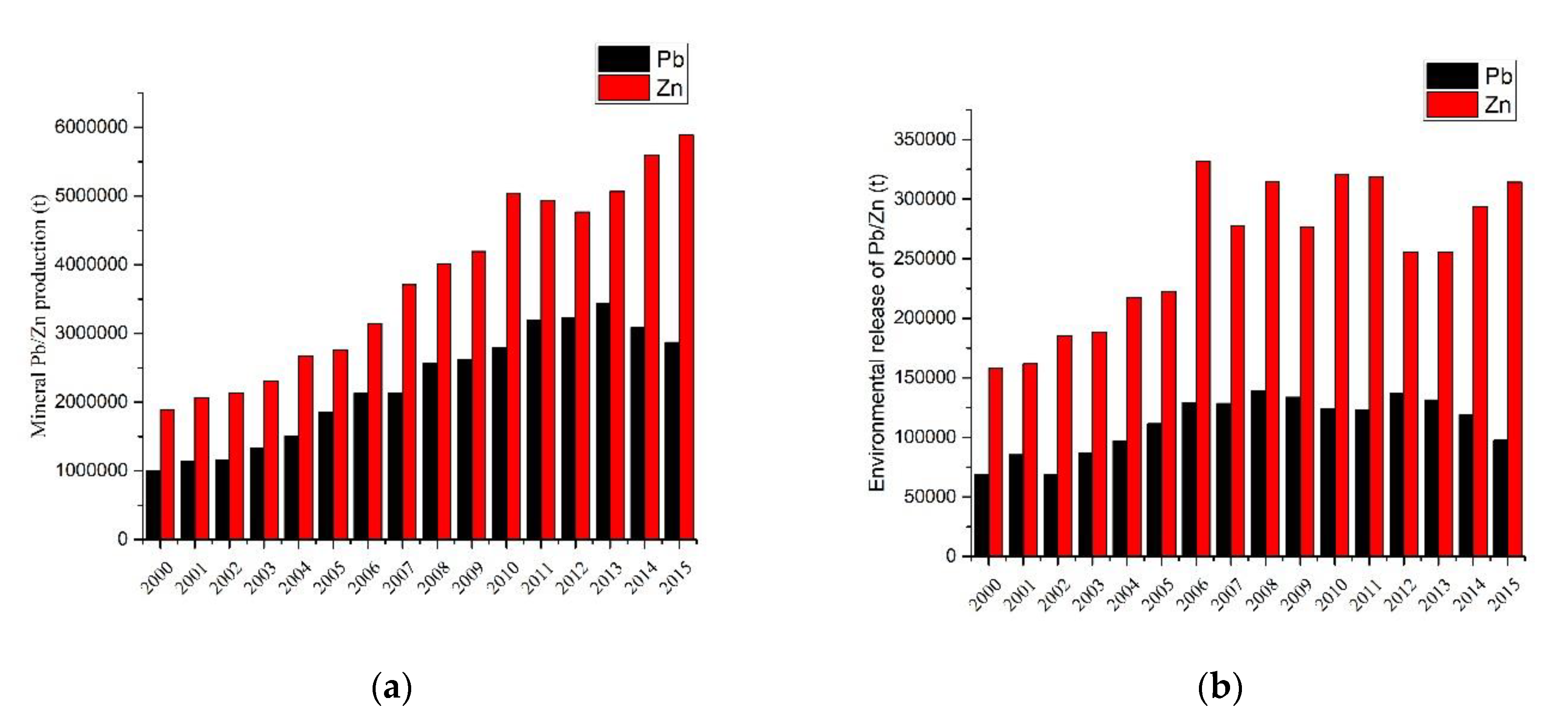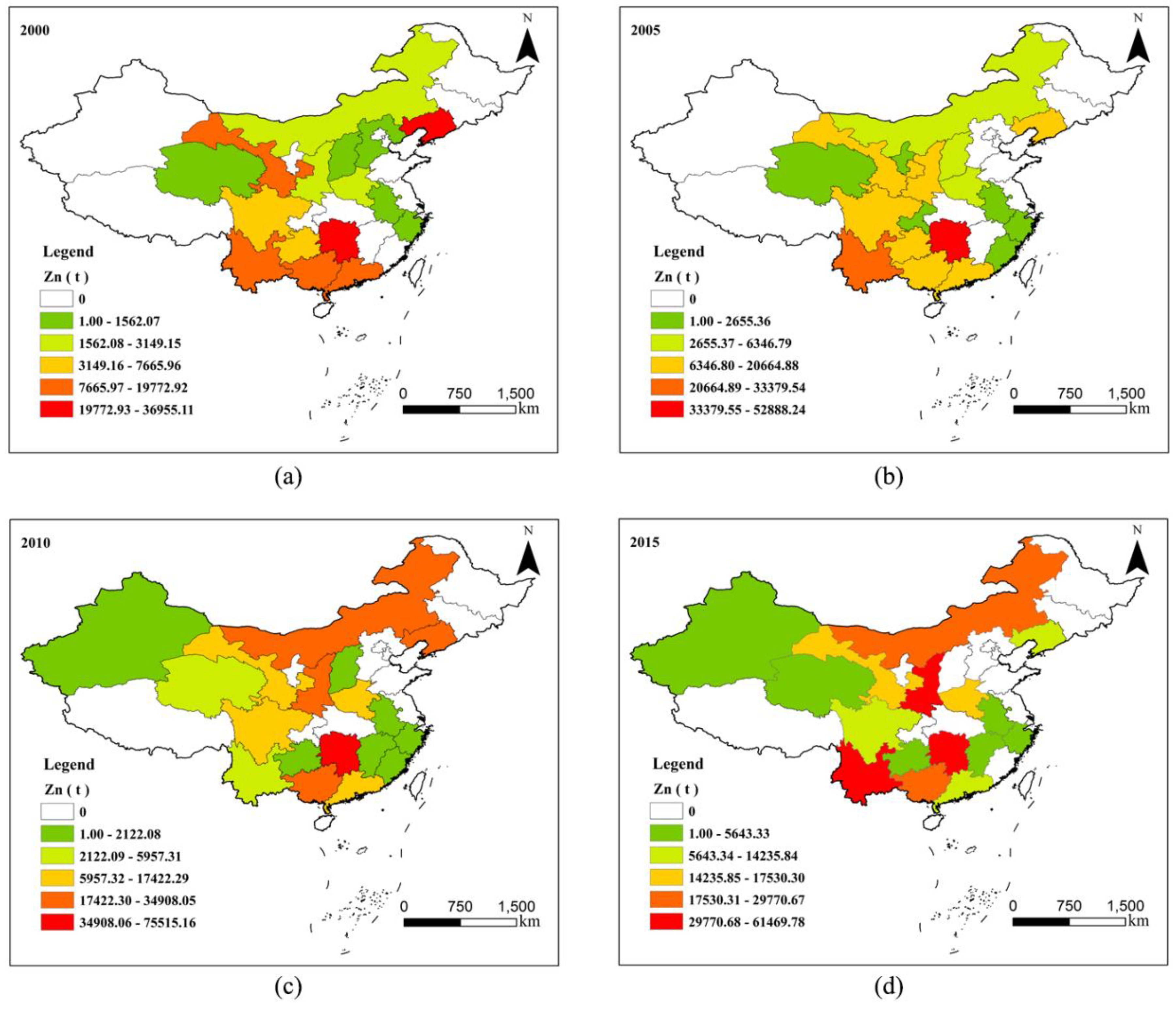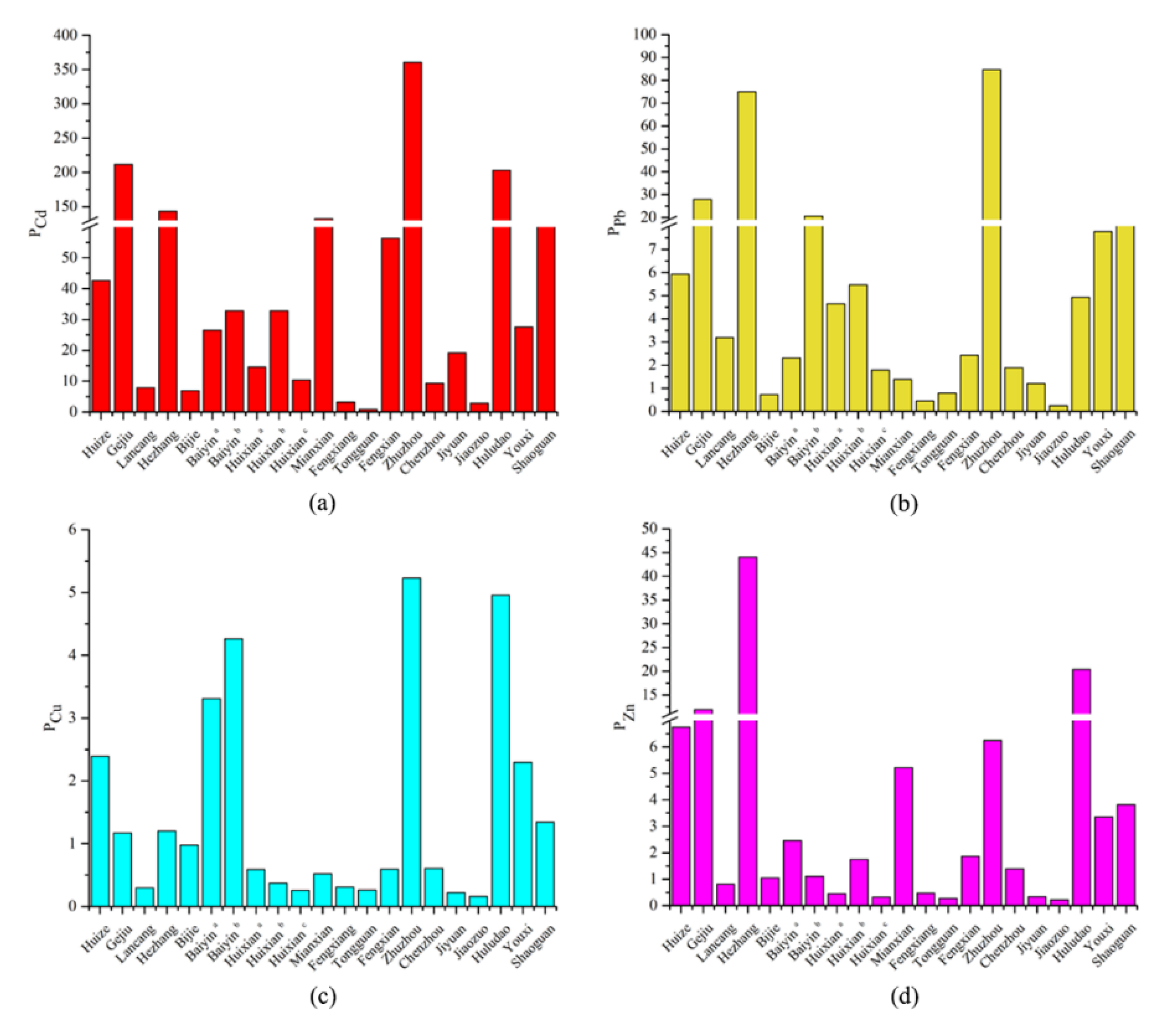Spatiotemporal Variation and Pollution Assessment of Pb/Zn from Smelting Activities in China
Abstract
1. Introduction
2. Materials and Methods
2.1. Materials
2.1.1. Pb/Zn Environment Release during Smelting
2.1.2. The Content of Heavy Metals in Soil from Pb/Zn Smelting Areas
2.2. Methods
2.2.1. Spatial Autocorrelation Analysis
2.2.2. Evaluation of Soil Heavy Metal Pollution
2.2.3. Potential Ecological Risk Assessment
3. Results and Discussion
3.1. Spatial and Temporal Variations in Pb/Zn Eenvironmental Release
3.1.1. Temporal Variation in Pb/Zn Environmental Release
3.1.2. Spatiotemporal Variation in Pb/Zn Environmental Release
3.2. Spatial Autocorrelation Analysis of Pb/Zn Environmental Release
3.3. Pollution Assessment of Soil Heavy mMetals in Pb/Zn Smelting Areas
3.3.1. Content of Heavy Metals in Soil
3.3.2. Pollution Assessment of Heavy Metals in Soil
3.4. Potential Ecological Risk Assessment
4. Conclusions
Author Contributions
Funding
Conflicts of Interest
References
- Du, F.; Yang, Z.G.; Liu, P.; Wang, L. Accumulation, translocation, and assessment of heavy metals in the soil-rice systems near a mine-impacted region. Environ. Sci. Pollut. Res. 2018, 25, 32221–32230. [Google Scholar] [CrossRef] [PubMed]
- Tepanosyan, G.; Sahakyan, L.; Belyaeva, O.; Maghakyan, N.; Saghatelyan, A. Human health risk assessment and riskiest heavy metal origin identification in urban soils of Yerevan, Armenia. Chemosphere 2017, 184, 1230–1240. [Google Scholar] [CrossRef] [PubMed]
- Xu, D.M.; Zhang, J.Q.; Yan, B.; Liu, H.; Zhang, L.L.; Zhan, C.L.; Zhang, L.; Zhong, P. Contamination characteristics and potential environmental implications of heavy metals in road dusts in typical industrial and agricultural cities, southeastern Hubei Province, Central China. Environ. Sci. Pollut. Res. 2018, 25, 36223–36238. [Google Scholar] [CrossRef] [PubMed]
- Douay, F.; Pelfrêne, A.; Planque, J.; Fourrier, H.; Richard, A.; Roussel, H.; Girondelot, B. Assessment of potential health risk for inhabitants living near a former lead smelter, part 1L metal concentrations in soils, agricultural crops, and home-grown vegetables. Environ. Monit. Assess. 2013, 185, 3665–3680. [Google Scholar] [CrossRef]
- Khalid, S.; Shahid, M.; Natasha Bibi, I.; Sarwar, T.; Shah, A.H.; Niazi, N.K. A Review of Environmental Contamination and Health Risk Assessment of Wastewater Use for Crop Irrigation with a Focus on Low and High-Income Countries. Int. J. Environ. Res. Public Health 2018, 15, 895. [Google Scholar] [CrossRef] [PubMed]
- Khan, A.; Khan, S.; Khan, M.A.; Qamar, Z.; Waqas, M. The uptake and bioaccumulation of heavy metals by food plants, their effects on plants nutrients, and associated health risk: A review. Environ. Sci. Pollut. Res. Int. 2015, 22, 13772–13779. [Google Scholar] [CrossRef]
- Li, X.Y.; Li, Z.G.; Lin, C.J.; Bi, X.Y.; Liu, J.L.; Feng, X.; Zhang, H.; Chen, J.; Wu, T.T. Health risks of heavy metal exposure through vegetable consumption near a large-scale Pb/Zn smelter in central China. Ecotoxicol. Environ. Saf. 2018, 161, 99–110. [Google Scholar] [CrossRef]
- Mackay, A.K.; Taylor, M.P.; Munksgaard, N.C.; Hudson-Edwards, K.A.; Burn-Nunes, L. Identification of environmental lead sources and pathways in a mining and lead smelting town: Mount Isa, Australia. Environ. Pollut. 2013, 180, 304–311. [Google Scholar] [CrossRef]
- Jeon, S.K.; Kwon, M.J.; Yang, J.S.; Lee, S. Identifying the source of Zn in soils around a Zn smelter using Pb isotope ratios and mineralogical analysis. Sci. Total Environ. 2017, 601–602, 66–72. [Google Scholar] [CrossRef]
- Ettler, V. Soil contamination near non-ferrous metal smelters: A review. Appl. Geochem. 2016, 64, 56–74. [Google Scholar] [CrossRef]
- Li, P.Z.; Lin, C.Y.; Cheng, H.G.; Duan, X.L.; Lei, K. Contamination and health risks of soil heavy metals around a lead/zinc smelter in southwestern China. Ecotoxicol. Environ. Saf. 2015, 113, 391–399. [Google Scholar] [CrossRef]
- Yu, Z.; Chen, F.; Zhang, J.F.; Huang, D.K.; Yu, E.J.; Liu, H.Y. Contamination and risk of heavy metals in soils and vegetables from zinc smelting area. China Environ. Sci. 2019, 39, 2086–2094. [Google Scholar]
- Kang, M.J.; Kwon, Y.K.; Yu, S.; Lee, P.K.; Park, H.S.; Song, N. Assessment of Zn pollution sources and apportionment in agricultural soils impacted by a Zn smelter in South Korea. J. Hazard. Mater. 2019, 364, 475–487. [Google Scholar] [CrossRef] [PubMed]
- Ghayoraneh, M.; Qishlaqi, A. Concentration, distribution and speciation of toxic metals in soils along a transect around a Zn/Pb smelter in the northwest of Iran. J. Geochem. Explor. 2017, 180, 1–14. [Google Scholar] [CrossRef]
- Zhang, T.; Xu, W.X.; Lin, X.N.; Yan, H.L.; Ma, M.; He, Z.Y. Assessment of heavy metals pollution of soybean grains in North Anhui of China. Sci. Total Environ. 2019, 646, 914–922. [Google Scholar] [CrossRef]
- Lee, P.K.; Kang, M.J.; Yu, S.Y.; Kwon, Y.K. Assessment of trace metal pollution in roof dusts and soils near a large Zn smelter. Sci. Total Environ. 2020, 713, 1–13. [Google Scholar] [CrossRef]
- Manceau, A.; Lanson, B.; Schlegel, M.L.; Harge, J.C.; Musso, M.; Eybert-Berard, L.; Hazemann, J.L.; Chateigner, D.; Lamble, G.M. Quantitative Zn speciation in smelter-contaminated soils by EXAFS spectroscopy. Am. J. Sci. 2000, 300, 289–343. [Google Scholar] [CrossRef]
- Yuan, Y.Q.; Xiang, M.; Liu, C.Q.; Theng, B.K.G. Chronic impact of an accidental wastewater spill from a smelter, China: A study of health risk of heavy metal(loid)s via vegetable intake. Ecotoxicol. Environ. Saf. 2019, 182, 109401. [Google Scholar] [CrossRef]
- Pacyna, J.M.; Pacyna, E.G. An assessment of global and regional emissions of trace metals to the atmosphere from anthropogenic sources. Environ. Rev. 2001, 9, 269–298. [Google Scholar] [CrossRef]
- Wilkin, R.T.; Lee, T.R.; Beak, D.G.; Anderson, R.; Burns, B. Groundwater co-contaminant behavior of arsenic and selenium at a lead and zinc smelting facility. Appl. Geochem. 2018, 89, 255–264. [Google Scholar] [CrossRef]
- Zhang, M.J. A brief analysis of the status and yield forecast of lead and zinc industry in China. China Nonferrous Metals 2018, 423–428. [Google Scholar]
- Shen, F.; Liao, R.M.; Ali, A.; Mahar, A.; Guo, D.; Li, R.H.; Sun, X.N.; Awasthi, M.K.; Wang, Q.; Zhang, Z.Q. Spatial distribution and risk assessment of heavy metals in soil near a Pb/Zn smelter in Feng County, China. Ecotoxicol. Environ. Saf. 2017, 139, 254–262. [Google Scholar] [CrossRef]
- Diawara, M.M.; Shrestha, S.; Carsella, J.; Farmer, S. Smelting remains a public health risk nearly a century later: A case study in Pueblo, Colorado, USA. Int. J. Environ. Res. Public Health 2018, 15, 932. [Google Scholar] [CrossRef] [PubMed]
- Zheng, N.; Wang, Q.C.; Zheng, D.M. Health risk of Hg, Pb, Cd, Zn, and Cu to the inhabitants around Huludao zinc plant in China via consumption of vegetables. Sci. Total Environ. 2007, 383, 81–89. [Google Scholar] [CrossRef] [PubMed]
- Lei, M.; Zeng, M.; Zheng, Y.M.; Liao, B.H.; Zhu, Y.G. Heavy metals pollution and potential ecological risk in paddy soils around mine areas and smelting areas in Hunan Province. Acta Sci. Circumst. 2008, 28, 1212–1220. [Google Scholar]
- Cappuyns, V.; Swennen, R.; Vandamme, A.; Niclaes, M. Environmental impact of the former Pb–Zn mining and smelting in East Belgium. J. Geochem. Explor. 2006, 88, 6–9. [Google Scholar] [CrossRef]
- Sutkowska, K.; Czech, T.; Teper, L.; Krzykawski, T. Heavy metals soil contamination induced by historical zinc smelting in Jaworzno. Ecol. Chem. Eng. 2013, 12, 1441–1450. [Google Scholar]
- Zhang, X.W.; Yang, L.S.; Li, Y.H.; Li, H.R.; Wang, W.Y.; Ge, Q.S. Estimation of lead and zinc emissions from mineral exploitation based on characteristics of lead/zinc deposits in China. Trans. Nonferrous Met. Soc. China 2011, 21, 2513–2519. [Google Scholar] [CrossRef]
- Shen, C.H.; Li, C.L.; Si, Y.L. Spatio-temporal autocorrelation measures for nonstationary series: A new temporally detrended spatio-temporal Moran’s index. Phys. Lett A 2016, 380, 106–116. [Google Scholar] [CrossRef]
- Lei, K.; Giubilato, E.; Critto, A.; Pan, H.Y.; Lin, C.Y. Contamination and human health risk of lead in soils around lead/zinc smelting areas in China. Environ. Sci. Pollut. Res. 2016, 23, 13128–13136. [Google Scholar] [CrossRef]
- Hakanson, L. An ecological risk index for aquatic pollution control-a sedimentological approach. Water Res. 1980, 14, 975–1001. [Google Scholar] [CrossRef]
- Li, R.H.; Shen, F.; Li, X.L.; Zhang, Z.Q.; Wang, J. Theoretical research and immobilization practice of heavy metal polluted soil in a closed lead-zinc smelter and surrounding farmland in Tongguan, Shaanxi. J. Agro Environ. Sci. 2015, 34, 1269–1276. [Google Scholar]
- Jiang, Y.; Zhan, X.W.; Sun, L.D.; Xiao, R.M.; Huang, Z.L.; Huang, Z.S. The formation distribution of Zn, Cu and Pb and Cd in the soil nearby the smelter. Guangdong Chem. Ind. 2011, 38, 110–112. [Google Scholar]
- Xiong, G.H.; Huang, K.; Luan, J.L.; Zhang, S.N. Characteristics of heavy metal pollution in soil around lead-zinc smelting plant. J. Kunming Univ. Sci. Technol. 2015, 40, 103–109. [Google Scholar]
- Bi, X.Y.; Feng, X.B.; Yang, Y.G.; Qiu, G.L.; Li, G.H.; Li, F.L.; Liu, T.Z.; Fu, Z.Y.; Jin, Z.S. Environmental contamination of heavy metals from zinc smelting areas in Hezhang County, western Guizhou, China. Environ. Int. 2006, 32, 883–890. [Google Scholar] [CrossRef] [PubMed]
- Li, X.H.; Tang, Z.L. Concentration distribution of Cd, Cu, Pb, and Zn in soil around smelter in Baiyin city, Gansu Province. Geotech. Investig. 2007, 5, 23–27. [Google Scholar]
- Huang, T.L.; Jin, M.H. Assessment of heavy metal quality status impact in the soil of Baiyin nonferrous metal production base. Gansu Metall. 2012, 34, 89–92. [Google Scholar]
- Zhan, H.Y.; Jiang, Y.F.; Yuan, J.M.; Hu, X.F.; Nartey, O.D.; Wang, B.L. Trace metal pollution in soil and wild plants from lead-zinc smelting areas in Huixian County, Northwest China. J. Geochem. Explor. 2014, 147, 182–188. [Google Scholar] [CrossRef]
- Zeng, Y.M.; Ye, Z.R. Characteristics and assessment of soil contamination by heavy metals around zinc smelting plant of Huixian. Sci. Technol. Inf. 2010, 7, 346–347. [Google Scholar]
- Hu, X.F.; Jiang, Y.F.; Zhan, H.Y.; Zhu, K. Study on transformation of heavy metal in soil from typical Pb-Zn smelting areas. Environ. Monit. China 2015, 31, 92–97. [Google Scholar]
- Wang, Y.Y.; Liu, D.M.; Sun, T.; Yu, Z.W.; Xu, H.P.; Tang, B. Characteristic analysis and evaluation of heavy metal content in soil around a smelter. Guangzhou Chem. Industry 2019, 47, 128–131, 140. [Google Scholar]
- Liu, Y.; Wang, C.J.; Liu, H.; Ma, H.Z.; Zhang, Q.H.; Feng, T.; Sun, D.L. Spatial distribution and ecological risk assessment of heavy metals in soil around a lead and zinc smelter. Chin. J. Environ. Eng. 2015, 9, 477–484. [Google Scholar]
- Liu, Z.F.; Hu, S.B.; Song, F.M.; Zhao, Z.P.; Li, C.; Ge, H.G. Pollution characteristics and speciation analysis of heavy metals in soils around a lead-zinc smelter area in Shaanxi Province, China. J. Agro Environ. Sci. 2019, 38, 818–823. [Google Scholar]
- Xu, Z.J.; Shi, H.W.; Qiu, X.Y. Uptake and bioconcentration of heavy metals by vegetables around a lead-zinc smeltery. J. Hunan Univ. Sci. Technol. 2008, 23, 107–110. [Google Scholar]
- Lu, S.J.; Wang, Y.Y.; He, L.H. Heavy metal pollution and ecological risk assessment of the paddy soils near a smelting area in Hunan Province. Environ. Monit. China 2015, 31, 77–83. [Google Scholar]
- Cheng, Y.X.; Zhao, Z.S.; Wang, Y.Z.; Qiu, K.Y.; Fu, Y.L.; Zhao, X.X.; Li, L.P. Soil heavy metals pollution in the farmland near a lead smelter in Henan Province. Chin. J. Soil Sci. 2014, 45, 1505–1510. [Google Scholar]
- Wang, Y.Y.; Li, F.F.; Wang, X.Y.; Yang, Z.H.; Han, K.; Ruan, X.L. Spatial distribution and risk assessment of heavy metal contamination in surface farmland soil around a lead and zinc smelter. Environ. Sci. 2019, 40, 437–444. [Google Scholar]
- Zheng, N.; Wang, Q.C.; Liu, J.S.; Wang, Y.; Zhang, Z.S. Spatial variation of heavy metals contamination in the soil and vegetables of Huludao City. Environ. Sci. 2009, 30, 2071–2076. [Google Scholar]
- Guo, S.H. Effects of lead and zinc smelting on spatial anisotropy of heavy metals in soil. Chem. Eng. Equip. 2019, 4–7. Available online: http://www.cnki.com.cn/Article/CJFDTotal-FJHG201909002.htm (accessed on 17 March 2020).
- Wang, J.; Zhang, C.B.; Jin, Z.X. The distribution and phytoavailability of heavy metal fractions in rhizosphere soils of Paulowniu fortunei (seem) Hems near a Pb/Zn smelter in Guangdong, PR China. Geoderma 2009, 148, 299–306. [Google Scholar] [CrossRef]
- Li, L.P.; Zhang, Y.Q.; Ippolito, J.A.; Xing, W.Q.; Qiu, K.Y.; Yang, H. Lead smelting effects heavy metal concentrations in soils, wheat, and potentially humans. Environ. Pollut. 2020, 257, 113641. [Google Scholar] [CrossRef] [PubMed]
- Stefanowicz, A.M.; Kapusta, P.; Zubek, S.; Stanek, M.; Woch, M.W. Soil organic matter prevails over heavy metal pollution and vegetation as a factor shaping soil microbial communities at historical Zn-Pb mining sites. Chemosphere 2020, 240, 124922. [Google Scholar] [CrossRef] [PubMed]





| Year | Moran’s I | P-Value | E(I) | Z-Value | |
|---|---|---|---|---|---|
| Pb | 2000 | 0.0651 | 0.2252 | −0.03125 | 1.2128 |
| 2005 | −0.0327 | 0.9834 | −0.03125 | −0.0209 | |
| 2010 | −0.0109 | 0.7843 | −0.03125 | 0.2737 | |
| 2015 | −0.0118 | 0.7954 | −0.03125 | 0.2593 | |
| Zn | 2000 | 0.0686 | 0.2206 | −0.03125 | 1.2249 |
| 2005 | 0.1156 | 0.0637 | −0.03125 | 1.8539 | |
| 2010 | 0.0152 | 0.5398 | −0.03125 | 0.6131 | |
| 2015 | 0.0455 | 0.3514 | −0.03125 | 0.9318 |
| Region | N | Cd | Pb | Cu | Zn | Source |
|---|---|---|---|---|---|---|
| Huize, Yunnan | 23 | 12.80 | 712.00 | 239.00 | 1688.00 | [11] |
| Gejiu, Yunnan | 15 | 63.50 | 3347.50 | 117.00 | 2974.30 | [33] |
| Lancang, Yunnan | 53 | 2.36 | 287.79 | 14.79 | 161.94 | [34] |
| Hezhang, Guizhou | 8 | 43.00 | 9000.00 | 120.00 | 11,000.00 | [35] |
| Bijie, Guizhou | 101 | 2.07 | 87.18 | 97.81 | 261.00 | [12] |
| Baiyin a, Gansu | 33 | 15.93 | 392.59 | 330.81 | 737.18 | [36] |
| Baiyin b, Gansu | 16 | 19.70 | 3510.00 | 426.00 | 332.00 | [37] |
| Huixian a, Gansu | 21 | 4.37 | 418.00 | 29.50 | 90.10 | [38] |
| Huixian b, Gansu | 27 | 9.85 | 655.89 | 37.24 | 435.89 | [39] |
| Huixian c, Gansu | 20 | 3.12 | 214.00 | 25.80 | 79.50 | [40] |
| Mianxian, Shaanxi | 17 | 39.74 | 165.08 | 52.05 | 1304.27 | [41] |
| Fengxiang, Shaanxi | 27 | 0.95 | 53.50 | 30.81 | 118.27 | [42] |
| Tongguan, Shaanxi | 18 | 0.26 | 94.63 | 26.10 | 68.60 | [32] |
| Fengxian, Shaanxi | 9 | 33.79 | 412.28 | 59.14 | 556.73 | [43] |
| Zhuzhou, Hunan | 10 | 108.18 | 7621.86 | 261.41 | 1249.20 | [44] |
| Chenzhou, Hunan | 35 | 2.80 | 226.50 | 60.50 | 347.10 | [45] |
| Jiyuan, Henan | 45 | 5.75 | 145.00 | 22.00 | 84.70 | [46] |
| Jiaozuo, Henan | 135 | 1.70 | 42.33 | 15.98 | 67.77 | [47] |
| Huludao, Liaoning | 113 | 60.94 | 443.10 | 247.80 | 4084.00 | [48] |
| Youxi, Fujian | 12 | 8.28 | 699.25 | 114.88 | 670.47 | [49] |
| Shaoguan, Guangdong | 13 | 25.61 | 1185.66 | 67.13 | 764.12 | [50] |
© 2020 by the authors. Licensee MDPI, Basel, Switzerland. This article is an open access article distributed under the terms and conditions of the Creative Commons Attribution (CC BY) license (http://creativecommons.org/licenses/by/4.0/).
Share and Cite
Zang, Z.; Li, Y.; Li, H.; Guo, Z.; Zhang, R. Spatiotemporal Variation and Pollution Assessment of Pb/Zn from Smelting Activities in China. Int. J. Environ. Res. Public Health 2020, 17, 1968. https://doi.org/10.3390/ijerph17061968
Zang Z, Li Y, Li H, Guo Z, Zhang R. Spatiotemporal Variation and Pollution Assessment of Pb/Zn from Smelting Activities in China. International Journal of Environmental Research and Public Health. 2020; 17(6):1968. https://doi.org/10.3390/ijerph17061968
Chicago/Turabian StyleZang, Zhenfeng, Yonghua Li, Hairong Li, Zhaohui Guo, and Ru Zhang. 2020. "Spatiotemporal Variation and Pollution Assessment of Pb/Zn from Smelting Activities in China" International Journal of Environmental Research and Public Health 17, no. 6: 1968. https://doi.org/10.3390/ijerph17061968
APA StyleZang, Z., Li, Y., Li, H., Guo, Z., & Zhang, R. (2020). Spatiotemporal Variation and Pollution Assessment of Pb/Zn from Smelting Activities in China. International Journal of Environmental Research and Public Health, 17(6), 1968. https://doi.org/10.3390/ijerph17061968





